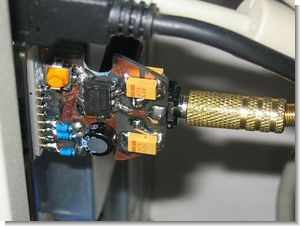
To use the lpt parallel port output as an audio output, a simple circuit tda7050 is used to amplify the sound in the output stage. This integrated is generally used in mp3 players, headphones, and can be used in different ICs by paying attention to the feeding chassis and audio input ends, for example tda2822
LPT Audio Circuit Project

Active Covox (D/A converter to parallel port)
A friend advised me to use the TDA7050 circuit 30.- (GME), which I use as a built-in amplifier powered from the remaining LPT lines. The circuit should run 1.6V up. Output impedance is 32ohm. I made the R-2R resistor network from 10k and 20k 1% SMD resistors. I’ve managed to cram it all onto a double-sided printed circuit board (yes, I’ve had enough of a spirit bottle) into the ball connector housing. Here is the schematic:
Surprisingly, the link worked on the first try :). First of all, I did a test on the LPT port of my computer and measured how and how much the supply voltage from the remaining data lines dropped. I noticed a drop from 4.5V to 3.1V, which is totally enough for the amplifier to work. I had to use a trimmer to reduce the amplifier’s gain because it was too large and paradoxically stopped playing altogether when overexcited. I had a hunch that the ports on the laptop would be weak, which was confirmed when it dropped from 4.7V to 2.0V. It was still adequate for normal listening but even when I bent it a little more it started to distort a lot. So I switched to the external power supply that I came up with out of the box with a cable going to the diode (cathode) plugged into the PS/2 connector (+5V) socket for the external keyboard.

Covox was supported by a number of historical module players (.MOD, .XM, .S3M, .IT…), the best of which is probably Fast Tracker II, which plays really well on Covox. I was also interested in the possibility of playing .MP3 files and found a DOS program, Digital Sound System 3.1, but it produces regular bursts of about 2x per second during playback.
Finally, I found the LPTDAC project on a German site, where the author has a driver for Windows 3.x (also with sources from TASM) and it works on Windows 95 OSR2 as well as I tested it. I’ve noticed that the audio plays a little faster (it’s because of the timer divider and sample rate for DMA), but I don’t mind that, otherwise the audio is pretty good. I play MP3s with the old WinAmp 2.08 and you can do other things while listening. It’s okay to use another program for playback, as the drive acts like a virtual SoundBlaster. Too bad someone didn’t program a plugin to be directly optimized for WinAmp.
What can I say in conclusion, it definitely plays better than a regular PC squeaker for a few crowns and can sometimes come in handy somewhere away from your PC and amp. It’s definitely not Hi-Fi, but still better than a wire in the eye (I’m aware of the existence of 16-bit stereo converters to LPT, but that would be another chapter). Here’s an audio sample to give you an idea – XM format played by Fast Tracker II 2.08 and sampled back to PC in SB Live
source http://rayer.ic.cz/elektro/covox.htm
Published: 2010/01/06 Tags: analog circuits projects
LM358 Sound Detector Circuit
According to media volume on the circuit at the output relay opening and closing sensitivity can be adjusted with potentiometer RV1 RV2 100k.
LM358 opamp amplifier used in the section on the floor of the driver pulled the residence time of the relay CD4528 Rv3 setting and C11, R18 resistor and capacitor values can be adjusted by changing. Ares proteus isis circuit diagram of the circuit and PCB’s drawings.
Sound Detector Project